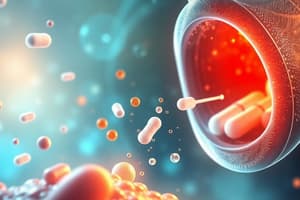Podcast
Questions and Answers
What is the primary goal of formulation development in nasal drug delivery?
What is the primary goal of formulation development in nasal drug delivery?
- To extend drug shelf life
- To reduce drug cost
- To ensure optimal bioavailability and efficacy (correct)
- To enhance drug toxicity
What is a critical physicochemical property to consider during formulation development?
What is a critical physicochemical property to consider during formulation development?
- Particle shape and color
- Particle size and surface area (correct)
- Particle density and viscosity
- Particle texture and smell
What is the primary function of mucociliary clearance in nasal drug delivery?
What is the primary function of mucociliary clearance in nasal drug delivery?
- To remove mucus from the nasal cavity (correct)
- To prevent enzymatic degradation
- To promote drug metabolism
- To enhance drug absorption
What is the primary advantage of using micro- and nano-particulates in nasal drug delivery?
What is the primary advantage of using micro- and nano-particulates in nasal drug delivery?
What is the primary role of excipients in nasal drug delivery?
What is the primary role of excipients in nasal drug delivery?
What is a major challenge in formulation development for nasal drug delivery?
What is a major challenge in formulation development for nasal drug delivery?
What is the primary advantage of using mucoadhesive systems in nasal drug delivery?
What is the primary advantage of using mucoadhesive systems in nasal drug delivery?
What is a critical consideration in the sterilization of nasal drug delivery formulations?
What is a critical consideration in the sterilization of nasal drug delivery formulations?
What is the primary role of lipid-based formulations in nasal drug delivery?
What is the primary role of lipid-based formulations in nasal drug delivery?
What is a critical consideration in the manufacturing of nasal drug delivery formulations?
What is a critical consideration in the manufacturing of nasal drug delivery formulations?
Flashcards are hidden until you start studying
Study Notes
Formulation Development in Nasal Drug Delivery
Importance of Formulation Development
- Crucial step in nasal drug delivery to ensure optimal bioavailability and efficacy
- Formulation development affects drug absorption, distribution, metabolism, and excretion (ADME)
Key Considerations in Formulation Development
- Physicochemical Properties:
- Drug solubility and partition coefficient
- pH-dependent solubility and stability
- Particle size and surface area
- Nasal Mucosa and Clearance:
- Mucociliary clearance and enzymes affecting drug absorption
- Nasal mucosa's role in drug metabolism and transport
- Delivery Systems and Excipients:
- Types of delivery systems: solutions, suspensions, gels, and powders
- Excipients: buffers, surfactants, and preservatives
- Stability and Sterilization:
- Formulation stability: chemical, physical, and microbiological
- Sterilization methods: filtration, radiation, and autoclaving
Formulation Strategies for Nasal Drug Delivery
- Micro- and Nano-Particulates:
- Enhanced bioavailability and controlled release
- Particle size and surface modification for optimal uptake
- Mucoadhesive Systems:
- Prolonged residence time and enhanced absorption
- Mucoadhesive polymers and their properties
- Lipid-Based Formulations:
- Liposomes, nanoemulsions, and self-emulsifying systems
- Enhanced solubility, stability, and bioavailability
Challenges and Opportunities in Formulation Development
- Nasal Mucosa's Complexity:
- Variability in nasal anatomy and physiology
- Enzymatic degradation and efflux transporters
- Scalability and Manufacturing:
- Production of consistent and stable formulations
- Regulatory requirements and quality control
Studying That Suits You
Use AI to generate personalized quizzes and flashcards to suit your learning preferences.




